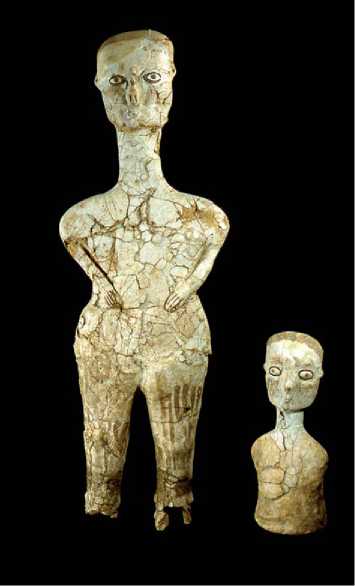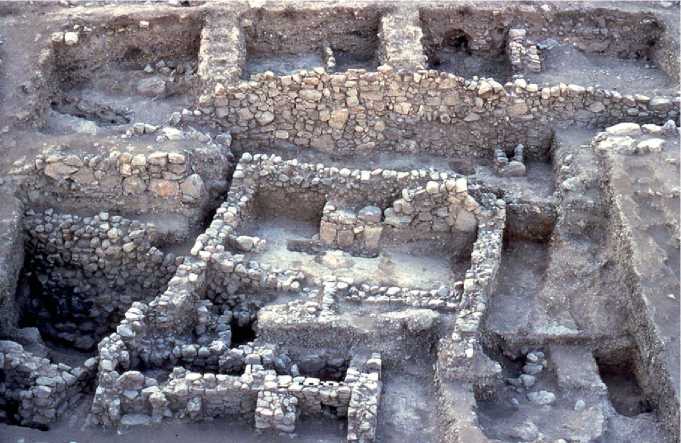Paleolithic (Old Stone Age): Hunter-Gatherers to Foragers
Lower At ‘Ubeidiya, near Lake Galilee, chopping stones and micromammal remains, related to the Oldowan Acheulean industry and dating to 1.4 million years ago, now provide clear evidence for the early movement ‘out of Africa’ of Homo erectus. Although fossil remains are few, and mostly in Late Acheulian
Israel (‘Ubeidiya, GesherBenot Ya‘akov, and Zuttiyeh’s Galilee Man), hand axes, wooden artifacts, and plant remains at Gesher Benot Ya’aqov, and the earliest known piece of art - a steatopygous female figurine - at Berekhat Ram in the Golan Heights, evidence a developing hunter-gatherer society some 600 000 years ago. Sites in the north (Yabrud, Adlun, Hummal, el-Kowm) reflect regional variations near the end (Acheulean-Yabrudian), underscoring developing diversity in the Levant.
Middle New radiometric dating methods have raised the start of this period considerably (250 00045 000 year ago), resulting in a greater overlap with the previous. An agreed demarcation, however, is the absence of bifacial (handax) tools, while the Levallois reduction technique (flake/blades) becomes characteristic. The best-known caves and rock shelters are situated in the Mediterranean core area, for example, Mount Carmel. The new dating has put those caves at the center of controversy (human origins), since archaic (Amud, Kebara, and Tabun caves) and modern humans (Qafzeh and Skhul caves) appear to be competitors using similar tools. Scholars remain divided on whether the Mount Carmel remains indicate that modern humans coexisted with or evolved from archaic humans.
Upper Archaeologists exploring beyond the core area have found open-air sites in semi-arid lands, revealing that by 47000-18 000 BCE modern humans showed astonishing adaptation, for example, Boker Tachtit (Negev), the Sinai, eastern Jordan’s Azraq Basin, Ksar Akil 25 (Lebanon), and Palmyra, and el-Koum (Syria). Accompanied with a toolkit of blades, there is a concomitant trend toward more mobile subsistence strategies and processing of plants, that is, foraging, whose clearest data are seen in the uppermost or Epipalaeolithic period.
Epipaleolithic: Foragers to Sedentists
One can best comprehend the Kebaran (c. 18 00012 000BCE) and Natufian (c. 12 000-9500BCE) as evincing a ‘broad spectrum revolution;’ that is, a hunting strategy (foraging) that exploits a wide variety of game, cereals, and legumes in a localized area. This strategy inevitably led to sedentism, namely, the multiphased, round hut villages of Eynan (Galilee), Mureybit and Abu Hureyra (Euphrates). Astonishingly, Abu Hureyra may have domesticated grain (rye); Mureybit yielded over a 100 species of seeds and plants. The archaeological correlates to grain processing are: sickles with silica, mortars and pestles (Hayonim Cave, Wadi Hammeh 27, Saaide II, and desert sites in Jordan); to long-distance trade: obsidian, Red Sea shells, and basalt; to symbolism: the sickle hafts and figurines - the first true art. More exciting is the recent discovery of Natufian-like behavior in the early Kebaran. The open-air sites of Neve David (Mount Carmel) and Ohalo II (Galilee) already display the characteristics of sedentism, including thousands of seeds at the latter site!
Neolithic: New Stone Age - Farmers, Herders, and Potters
Aceramic Neolithic
PPNA Coincidently or not, at the onset of the Holocene era (c. 9600 BCE), the revolutionary first unequivocal domestication of plants (einkorn wheat, barley, and pulses) occurred (subsequent to sedent-ism, not the reverse). Concurrent with domestication, the Pre-Pottery Neolithic A (PPNA) peoples crossed the threshold to permanent village settlements: Mureybit, Jerf el-Ahmar, Tell Aswad; in the south, Netiv Hagdud, ‘Iraq ed-Dubb, and Jericho, whose stone wall and ‘tower’ earned it the title, ‘earliest city in the world’. Wall paintings (Mureybit), auroch skulls on benches (Jerf al-Ahmar), along with decapitated burials and burning, suggest ritual communal buildings. Though foraging still dominates, as the first true arrowhead (notched el-Khiam point) indicates, developing social organization is implicit in these experimental farming villages.
PPNB As researchers now know, it was somewhat later (8300-6800 BCE) that plant domestication became widespread, followed by the domestication of goats and sheep. Surely implying population growth, mega-sites (25-35 acres), comprising large, multi-roomed, rectangular houses (‘Ain Ghazal, Wadi Shueib, Basta in Jordan, Abu Hureyra, and others in the north) now appeared. Their most recognizable attribute is the ever-present lime plaster, whether on floors and walls, in ‘white ware’, or, more spectacularly, on plastered skulls and figurines, even unique busts and statues, some almost 3' tall at ‘Ain Ghazal (Figure 1). The latter tradition, apparently an ancestor cult, is widespread (Bouqras, Tell Halula, Beisa-moun, Wadi Shu’eib, Tell Sabi Abyard). Other evidence of ritual includes: decapitated burials below floors, and sanctuaries (Beidha ‘Ain Ghazal, Tell Sabi Abyad II, Halulu). It is possible that the remarkable PPNB (Figure 2) period ended due to over-cultivation and environmental degradation by the population. Throughout the entire region, shifting settlement patterns, the abandonment of numerous sites, but occupational continuity at others, all suggest a dynamic

Figure 1 Female plaster statue and bust from the 1983 MPPNB statuary cache at ‘Ain Ghazal. Photo by Peter Dorrell and Stuart Laidlaw. Permission of the ‘Ain Ghazal Archaeological Project.
Period of transition to the pottery cultures of the Pottery Neolithic (PN).
PPNC This phase in the south equals the Final PPNB/ early PN in Syria. Discerned originally at ‘Ain Ghazal and now recognized at a handful of sites in the south, the PPNC links the PPN to the PN period, thus closing the hiatus palestinien proposed by Kathleen Kenyon on the basis of an abandonment at Jericho. In lithics (mostly flakes) and mortuary practices (skull intact), but especially in architectural remains (small singleroom houses and corridor structures for storage) and in faunal remains, a new mode of subsistence is perceptible: nomadic pastoralism. The seasonal herding of sheep and goats as a subsistence strategy distinct from sedentism may have arisen at this time due to the ecoenvironmental conditions, as noted previously.
Ceramic/Pottery Neolithic (PN) The transition (c. 6900 BCE in Syria) to widespread agricultural villages is cloudy, although continuity at a few sites (Abu Hureyra, Bouqras, Tell Ramad, Tell Sabi Abyad) alludes to a primarily indigenous process (also ‘Ain Ghazal in the south, early-mid sixth millennium). Typically, sites are small, dispersed, and short spanned, often in new locations (Amuq, Hama; in the south Munhatta, Sha‘ar ha-Golan). It is thought that the

Figure 2 The PPNB Lower Temple, dated to 7016 ± 132 cal BC. ‘Ain Ghazal Archaeologicao Project.
Photo by Bilal Deghedeh and Yousef Zu’bi. Permission of the
New pattern reflects the adaptation and consolidation of a ‘mixed farming’ regime, with its offshoot, pasto-ralism. Notably, in the north, there are a few larger regional sites; in the south, Sha‘ar ha-Golan has public buildings and a vast collection of female figurines.
Pottery making, a correlative process to PPNB lime-plaster technology, appeared c. 6900 BCE at Tell Damishlyiia and Tell Sabi Abyad, in the Jezirah (proto-Hassuna ware), and in the ‘Amuq (‘dark-faced burnished ware’), and later at ‘Ain Ghazal, in the south (Yarmoukian). Around 6000, exquisite red-painted Halaf ware appeared in the Jezireh, then spread to the coast along with an assemblage of tholoi, red-painted figurines, stamp seals, and clay sealings. Implying large-scale pottery production, specialized craftsmanship, and trade (seals), this growing complexity (in the north) accelerated in the following period.




 World History
World History





![Black Thursday [Illustrated Edition]](https://www.worldhistory.biz/uploads/posts/2015-05/1432470149_1431513568_003514b1_medium.jpeg)



